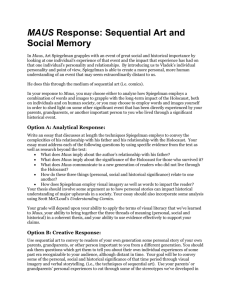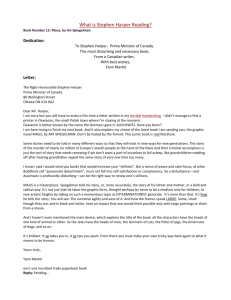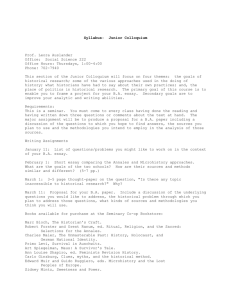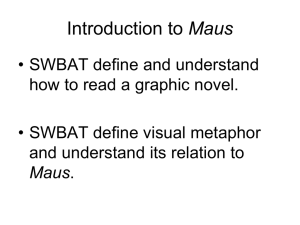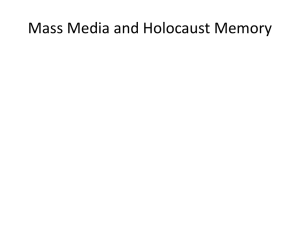1 Professor Carol Weir Hunter College Email
advertisement
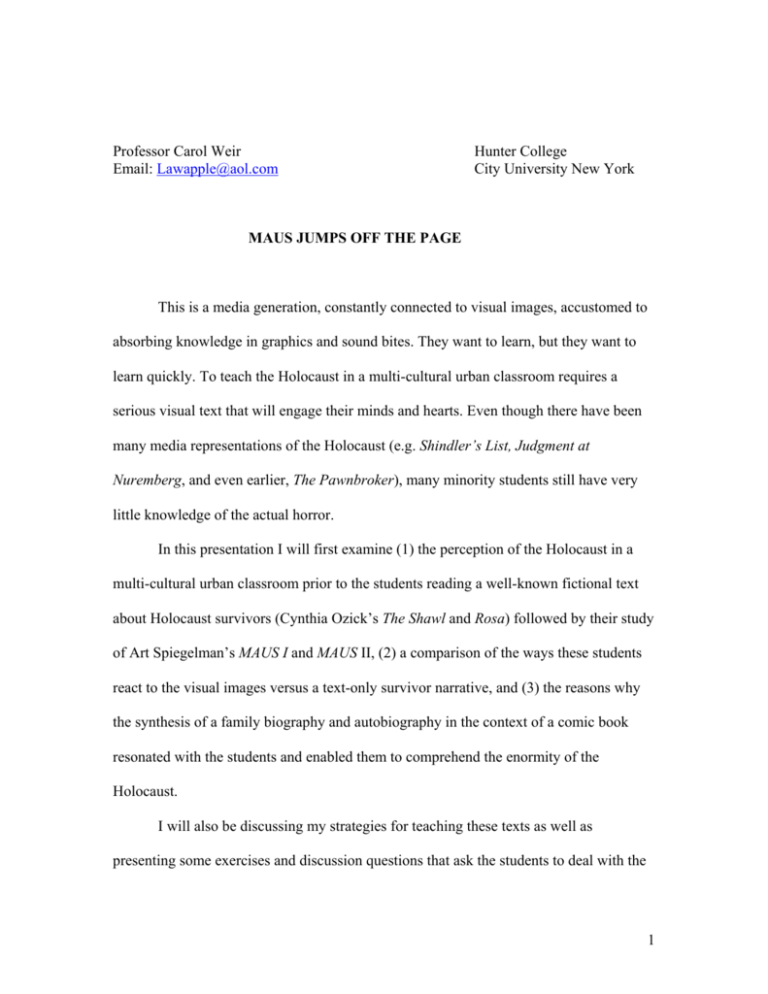
Professor Carol Weir Email: Lawapple@aol.com Hunter College City University New York MAUS JUMPS OFF THE PAGE This is a media generation, constantly connected to visual images, accustomed to absorbing knowledge in graphics and sound bites. They want to learn, but they want to learn quickly. To teach the Holocaust in a multi-cultural urban classroom requires a serious visual text that will engage their minds and hearts. Even though there have been many media representations of the Holocaust (e.g. Shindler’s List, Judgment at Nuremberg, and even earlier, The Pawnbroker), many minority students still have very little knowledge of the actual horror. In this presentation I will first examine (1) the perception of the Holocaust in a multi-cultural urban classroom prior to the students reading a well-known fictional text about Holocaust survivors (Cynthia Ozick’s The Shawl and Rosa) followed by their study of Art Spiegelman’s MAUS I and MAUS II, (2) a comparison of the ways these students react to the visual images versus a text-only survivor narrative, and (3) the reasons why the synthesis of a family biography and autobiography in the context of a comic book resonated with the students and enabled them to comprehend the enormity of the Holocaust. I will also be discussing my strategies for teaching these texts as well as presenting some exercises and discussion questions that ask the students to deal with the 1 themes of memory, guilt and loss, and the significance of those themes in negotiating the Holocaust. Included in this presentation are excerpts from papers written by these students in response to an essay assignment that required research into literary sources. I teach at Hunter College, part of The City University of New York (CUNY), the nation’s largest urban institution. CUNY comprises 11 senior colleges, six community colleges, a graduate school, a law school and a medical school. Hunter is one of the senior colleges. Founded in 1870, Hunter is one of the oldest public colleges in the country, dedicated from its earliest days to serving a student body that reflects the diversity of New York City. Known for its rich and academically rigorous environment, Hunter College takes pride in a curriculum as diverse as its community. Hunter faculty and students come from virtually every nation and culture in the world. In the 1930’s CUNY’s student body was predominately first generation working class and the mission of CUNY was to serve that population. Today, CUNY still serves this mission, but Hunter College is presently located on the Upper East Side of Manhattan, on one of the most valuable pieces of real estate in the city. It is worth noting that practically none of the students who attend Hunter live in this fashionable neighborhood; instead, most come from the Bronx, Brooklyn or Queens. Accordingly, as they negotiate the campus, they are also negotiating class and race, a fact that particularly affects student of color and working class students, most of whom commute to school from their home neighborhoods. The course that I teach and that prompted this presentation is an upper-level English Course entitled, appropriately, “Jewish-American literature.” The students who enroll in this course are occasionally English majors, but not necessarily. Sometimes the 2 course is selected by a student based solely on the time is it offered, or to satisfy a requirement to take a literature course dealing with “diversity.” However, regardless of the reasons a student selects the course, in order to be eligible for registering, a student must have taken, as a minimum, introductory courses in composition and literature. Therefore, the class is generally composed of juniors and seniors, having an average age of 20, although occasionally there is a returning student who is older. The class size is limited to thirty (30) students. In general, the religious background of the students is varied: predominately Christian, several Muslim, and a few Jewish students (often from Orthodox backgrounds). As an introductory assignment on the first day of class, I ask the students to give me a one or two page written response to the following question: “Discuss your general impressions of Jews, gained either from the media or from personal observation.” I use this assignment to not only evaluate the student’s writing ability, but also to ascertain their perceptions of Jews and the source of those perceptions prior to reading the assigned texts in the syllabus. I usually expect to receive descriptions based on stereotypes and my expectations are generally fulfilled. Students who have watched such sitcoms as “Seinfeld” and films like “Meet the Fockers” described Jews as loud, funny and able to make money. One particular student whose family apparently applied for public assistance, said that “the Jews got more food stamps than other people.” Only a few students mentioned The Holocaust in this initial assignment, but those who did almost always mentioned The Diary of Anne Frank. Actually, during their public school education in New York, The Diary of Anne Frank is often the only text that most 3 high school students read concerning what is a State-mandated unit on the Holocaust,1 leaving one student to comment (at the end of my course) that The Diary “is not enough to allow the complete education of today’s young people to the true ramifications of this event.” Another student said that Anne Frank’s story only “covers one inch long and one inch deep of the genocide of Jews,” and “that the image of the Shoah that the diary leaves the reader with is only that of a helpless girl hiding from doom.”(Lumley) Teaching the Holocaust is only a part of my syllabus in Jewish-American literature, but it is an important part. In my first lecture, I discuss the concept of Diaspora and make the students aware that in virtually all of the texts that they will be reading, certain themes will recur, namely questions of identity, and narratives about family, memory, loss, and being an outsider. I also let them know that discussion questions about each text will be sent to them prior to class and that certain students will be appointed discussion leaders for small group discussion. The first part of Jewish-American literature is devoted to some background in Yiddish literature (ex. stories by Isaac Bashevis Singer) followed by such classic texts as The Chosen by Chaim Potok and Seize the Day by Saul Bellow. Later in the semester, we also discuss Philip Roth’s The Human Stain, (selected for its themes of identity, memory and family), as well as recent novels by Allegra Goodman and Gary Shteyngart. To begin the subject of the Holocaust, I assign Cynthia Ozick’s short story, “The Shawl” (2000 words of finely honed impressionism, a rendering in miniature of the Holocaust) and the companion novella, “Rosa.” Ozick, of course, is not herself a 1 New York is one of seven states that mandate that Holocaust and genocide studies be taught at some point in elementary or secondary schools’ curriculum. There are no minimum requirements, and the amount of attention given to the Holocaust in public school varies widely, depending on the school. 4 survivor, but her fictional protagonist, Rosa, who watches her young daughter starve and die in a concentration camp, is as poignant and powerful a character as the eyewitness autobiographical accounts of either Elie Wiesel or Primo Levi, and both “The Shawl” and “Rosa” are on the reading lists of most college courses on Holocaust literature. Being fully aware that Judaism demands a living connection to history, and being strongly influenced by Rabbi Leo Baeck who spoke of “living history,” (Kauver xv) Ozick has asserted that what engages her are the “secrets of inheritance.” Echoing the famous quote of Theodore Adorno, 2 Ozick is quoted in The Paris Review as having said that she would prefer not to make art out of the Holocaust, “I don’t want to tamper or invent or imagine, and yet I have done it. I can’t not do it. It comes, It invades.” A Cynthia Ozick scholar points out that the Jewish tradition is full of meaningful interaction with historical texts and not just interacting, but “repairing the text” (Lowin 141). As a student noted in her paper on Ozick, Midrash embodies this desire to maintain an open, working relationship with the past. While one cannot rewrite the past, one may comment and re-interpret (Yamashiro). However, it is worth mentioning that Cynthia Ozick would most likely find MAUS and Spiegelman’s use of mice, cats and pigs, a highly objectionable representation of the Holocaust. Quoting from her recent argument in the Harvard Gazette: “The writer of fiction may alter and distort reality in any way he or she pleases, as long as the result possesses a consistency that allows readers to suspend their disbelief and accept the 2 “After Auschwitz it is barbaric to write poetry” 5 imaginative world the writer has created. The exception to this rule is when a fiction writer takes on the Holocaust.” 3 Student responses to Ozick indicate that the portrayal in “The Shawl” of the starving child Magda and the mother’s futile attempt to save her are almost too powerful for them to bear. Comparing Night and “The Shawl” to Maus, one student commented: “Because they deal with actual people going through these traumatic events, the reader becomes extremely invested in the well being of the protagonist and feels the pain that they are going through. There are often times while reading these stories that one must put down the book in order to take a step back from the upsetting stories and regain composure.” In her response paper, the student recounts the long death march described in “The Shawl” and quotes from the story: ‘Magda took Rosa’s nipple, and Rosa never stopped walking, a walking cradle. There was not enough milk; sometimes Magda sucked air, then she screamed. Stella [Rosa’s niece] was ravenous. Her knees were tumors on sticks, her elbows chicken bones.’ (Ozick 1). While reading this quote, one feels helpless. Having to imagine a mother unable to feed her newborn child because she herself is so malnourished is almost too hard to contend with.” (Schwartz) ------Immediately after the students finished discussion of “The Shawl” we turned to Art Spiegelman’s biography (and autobiography) entitled Maus I A Survivor’s Tale subtitled: My Father Bleeds History and Maus II A Survivor’s Tale with the subtitle: And Here My Troubles Began. Spiegelman’s unusual representation of the Holocaust in a comic format, with Jews represented as mice and Germans as cats (the Poles are shown 3 Gewertz, Ken. Ozick Assails Writer’s Lack of Responsibility. Harvard University Gazette 1 December 2005. 6 as pigs) has evoked many critical responses. I will not detail all of the literary criticism, but summarize as follows: (1) comics are a commercial art form, considered a “low” medium, compared to “literature;” (2) a serious subject, such as the Holocaust, should not be undermined by such a medium, (3) comics are often fun to read and the reader should not enjoy reading about the Holocaust. In response to such criticism, it is important to note that the message of the Holocaust reaches this media generation and enables them to internalize the horrific events in large part because of Spiegelman’s unique presentation. As several students noted: “Because Art Spiegelman’s Maus is written in the form of a comic book, it takes an appalling theme and makes it easier and more enjoyable to read than a novel on the same subject.” - and this quote: “Maus introduces an innovative way to tell the story of the Holocaust that allows it to be less emotional. Because Spiegelman was able to ‘reduce’ and ‘simplify’ the distress and suffering of the Holocaust it is easier to absorb and therefore makes it more enjoyable to read.” Umberto Eco, quoted on Maus’ back cover page, has this to say: Maus is a book that cannot be put down, truly, even to sleep. When two of the mice speak of love, you are moved, when they suffer, you week. Slowly, through this little tale comprised of suffering, humor and life’s daily trials, you are captivated by the language of an old Eastern European family, and drawn into the gentle and mesmerizing rhythm, and when you finish Maus, you are unhappy to have left that magical world and long for the sequel that will return you to it. Undoubtedly critics of Spiegelman would find such words as “gentle and mesmerizing” and “magical” inappropriate, but in my opinion as a teacher of the Holocaust, the importance of getting the message across, outweighs any other literary consideration. 7 I would like to note that in teaching the Holocaust, I also had the students view The Pawnbroker, a gritty black and white Sidney Lumet film made in 1965, adapted from the 1961 novel of the same name by Edward Lewis Wallant. In the film, starring Rod Steiger, a Holocaust survivor who lost his entire family goes through the motions of running a pawnbroker shop, assisted by a young Puerto Rican named Jesus. Unlike MAUS, which interposes some humorous anecdotes (usually involving Vladek’s parsimony), The Pawnbroker is unrelievedly grim, leaving the student audience as numb as the central character. “Too depressing” was the overwhelming response to the film, when I asked for their reaction. The surrogate father/son relationship between the pawnbroker and Jesus did not resonate with the students, whereas they clearly identified with the Artie/Vladek situation. In connection with the discussion questions sent to the students, I will comment on the importance of the family issues raised by Spiegelman’s synthesis of biography and autobiography. The two volumes of Maus were discussed during several class periods (each class period is seventy five minutes). As an introduction to the work, I re-introduce the topics of memory and loss, with some discussion of Freud, and ask the students to consider these themes as they read the books. I also make them aware that the texts contain complex time lines, shifting back and forth between the father’s life and the present and that the narrative voice alternates between the two protagonists. I cannot overstate the enthusiasm that these texts engendered with the class. Hardly any of them had ever heard of Spiegelman prior to taking this course, whereas as I have said earlier, almost all of them knew about Anne Frank and some had read Night. One student commented that “for me, it was more than just a text” and another was so 8 overwhelmed by reading Maus, that he told me he intended to tell his family and friends that “they must read these books.” It must be added that one of these students was halfMuslim and another was Christian. A teacher of literature is usually content when the students themselves have read the assigned texts and are able to analyze the meanings, but it is even more gratifying to hear that the texts will be imparted to others outside the classroom. Prior to our class discussion of Maus, I sent out the following discussion questions: 1. In his classic work “Mourning and Melancholia” Freud compares the two states. Mourning is seen as a physiological state and melancholy as a pathological one. If normal physiological mourning is prolonged, it may become melancholy, which Freud characterized as having three aspects: (a) loss of the loved/hated object with all the feelings that relate to it; (b) regression to narcissism – the subject identifies himself to the lost object; (c) ambivalent feelings towards the lost object. Discuss how this applies to Artie 2. In Chapter Two “Time Flies” the reader is flash forwarded to 1987 (Vladek lived from 1902-1982 and has already been dead five years) Artie (Art, the artistic self?) is depicted as wearing a mouse mask. Discuss why when the narrator is Artie, the son of Vladek, he is Depicted as a human with a mouse head. How is Vladek depicted? 3. As a father/son memoir, discuss whether Artie has been successful in reconciling with his father (and his memory). Has he worked towards forgiveness and acceptance? Not that at the end of the book Vladek lies down and says “I’m tired from talking, Richieu (Richieu was Artie’s younger brother who died in the camp – Spiegelman dedicates the book to both his brother and his deceased mother), and it’s enough stories for now.” Who gets the last word in…Vladek or Artie? 4. Spiegelman uses great detail: maps, how to fix shoes, and even a Diagram of the crematorium. Discuss the function of these details. In addition to the appeal of the comic book format to the students, the memoir of a son recounting, or attempting to recount, his father’s stories, held special interest. As 9 one student observed, “As he relates his father’s story, he also shows us the person who remained in the present day and the effect of being the child of one of these people. At various points in the story we see Spiegelman struggle with the rationale of his father’s cheapness, understanding how it would have been a result of the experiences, while simultaneously refusing to justify such behavior” (Slotnick). Unlike both Night and Survival in Auschwitz, where survivors Wiesel and Levi are presented with heroism and stoicism, Vladek the survivor is shown as a critical and overbearing father, often manipulative, sometimes even abusive (to his second wife Mala) and consistently demanding. Artie begins the first volume of Maus by telling the reader “I went out to see my Father in Rego Park (Queens)..I hadn’t seen him in a long time – we weren’t that close.” So here we have the classic family dynamic, a grown son trying both to establish his own identity and yet keep a relationship with his father. Accustomed as they are to viewing talk shows where guests bare their souls on TV, this is a story that most college students can easily identify with. As my class frequently said, “this story is so real “ Moreover, as the student readers saw Vladek continually criticize the author (even telling him what clothes to wear), and having “issues” with their own parents, they alternated between pity for the father and sympathy for the son. In addition to the father/son dynamic, the reader learns that Artie’s mother Anja has also survived the camp, but has committed suicide prior to the book’s opening, and Artie himself has undergone psychiatric treatment (prompted in part from feelings of guilt about his parents). Adding these contemporary social issues to the mix ensured that class discussion was lively and often extended beyond the boundaries of the classroom itself. 10 Besides the discussion of family issues, the students also related that Spiegelman’s use of graphic images made the events of the Holocaust much clearer to them. Several students noted that the boxes and panels of the comic strip format was not“overcluttered” and they could spend time looking at one panel for a period of time (for example, the map of the crematorium), whereas in a written text, the eye moved onto the next paragraph or page and seldom returned. In a very fine paper, one student compared Maus with Primo Levi’s classic text and noted that “the reading in Levi’s account is much more difficult and painful than the reading in Maus. Visually, of course, nothing relieves the sight of the small black letters on the page, which seem to become suffused with the pain of the content they convey. The eye would perhaps be grateful to have Maus-style visual images to rest upon, but the only relief Survival in Auschwitz offers is that of putting the book away” (Estline). Following the sessions devoted to class discussion, I assigned a five-page paper, requiring not only student response, but also the use of outside literary sources. I asked the students to consider whether Spiegelman’s choice of genre trivialized the Holocaust and “inverted” the norm, as literary critic Robert Leventhal has suggested. 4 None of the students thought that there had been trivialization or that the “reduction of the players to cats, mice, pigs and other national stereotypes offered a conscious, intentional miniaturization and reduction of the Nazi practices” (Leventhal). In quoting from student papers, I believe it is relevant to mention their ethnic and religious background. In a very perceptive paper, one Irish-American student wrote, “for almost fifty years a realist approach to portraying a hyper-reality has been the only universally 4 Leventhal, Robert S. Art Spiegelman’s MAUS: Working Through The Trauma of the Holocaust. University of Virginia. 1995. www.iath.Virginia.edu/holocaust/spiegelman. 11 approved way to try to translate this scope of human tragedy and cruelty” (Penney). He then goes on to discuss the shortcomings of a realist approach, quoting Lyotard who argues that realism is “an impossible idea in a postmodern world.” Another extremely bright student, Afro-American, commented that “To be fair, any artist who attempts any representation of the events or after effects of the Holocaust walks a very delicate tight rope” (Speights). He goes on to say that the first problem “consists of the delicacy of the issue.” In questioning whether “the events of Auschwitz are so heinous, so cruel, so tragic, so ‘evil’ that they are best not discussed at all” he concludes that the American media has chosen to take what he terms a “cookie cutter” formula for representing the Holocaust, and rather than raising the philosophical questions of how and why it happened, simplistically presents the issue of a struggle between “good versus evil.” His commends Spiegelman’s use of animal imagery for its examination of “the many ways of the dehumanizing system of oppression that was so much of Nazi Germany” (Speights). Another young Afro-American student wrote that “The depiction of Jews as mice and Germans as cats reflects comic traditions with which the readers may be comfortable; this choice enables the author to address the Holocaust in a different way, as an animal fable. I think that the use of animals was a great way to get readers more involved with the book without becoming judgmental about certain races” (Bruce). Another student (half-Muslim, half Christian) argued that Spiegelman’s “visual art, commentary, maps, dialogue boxes and most especially diagrams of gas chambers, bunkers and the actual physical camps has given the reader an (almost) first hand experience of not only what it 12 is to be a Holocaust survivor but also to make their own interpretations of what it entails to survive” (Akturk). Finally, in a very direct way, another Afro-American girl said, “Most narratives express in great detail, or in some cases, no detail at all the horrifying events that took place then. Even though the pictures are graphic, the descriptions in the usual Holocaust narratives are graphic through words. There is no picture to ease the heart of the person who just read about people being buried alive” (Bowles). Several of the Jewish students were at first offended by the portrayal of Jews as mice, “standing behind barbed wire, with their eyes peering and their faces oblong and gray…” and I was “debilitated just at the mere fact that a Jew would stoop so low as to illustrate himself, his family, and his people in a way that they were portrayed by the Nazis to the whole world” (Kogen), but then this student and others accepted the unique genre as a very effective metaphor of the events. Lastly, quoting from a very pragmatic Israeli student, after comparing Maus to such recent authors as Amir Gutfruend and David Grossman, she notes that “Spiegelman achieves something altogether new in Holocaust narratives: (he) manages to domesticate the Holocaust: it no longer exists under glass but emerges as a living narrative that keeps spilling over into ordinary life” (Mor). In conclusion, in teaching the Holocaust to this very special student audience, a microcosm of the world, it has been my experience that traditional narratives do not evoke the same response as they did for their parents and grandparents. If we want the memory to survive, we must adapt to the media culture, as Art Spiegelman has done, and keep the story fresh, graphic and powerful. 13 Works Cited Gewertz, Ken. Ozick Assails Writer’s Lack of Responsibility. Harvard University Gazette 1 December 2005. <http://www.news.harvard.edu/gazette/2005/12.01/15ozick.html> Kauver, Elaine, Ed. A Cynthia Ozick Reader. Indianapolis: Indiana University Press, 1996. Levi, Primo. Survival in Auschwitz. Trans. Stuart Woolf. New York: Touchstone, 1993. Lowin, Joseph. Cynthia Ozick. Boston: Twayne Publishing, 1988. Ozick, Cynthia. The Shawl. New York: Vintage Books, 1983. Spiegelman, Art. Maus I: My Father Bleeds History. New York: Pantheon Books, 1986. ----Maus II: And Here My Troubles Began. New York: Pantheon, 1992. Wiesel, Elie. Night. New York: Bantam Books, 1982. Student Papers Referenced Alexandra Akturk Aliah Bowles Lyle Bruce Leah Levin Estline Leah Kogen Katherine Lumley Alona Mor Timothy Penney Aryn Schwartz Jason Speights AikoYamashiro 14
